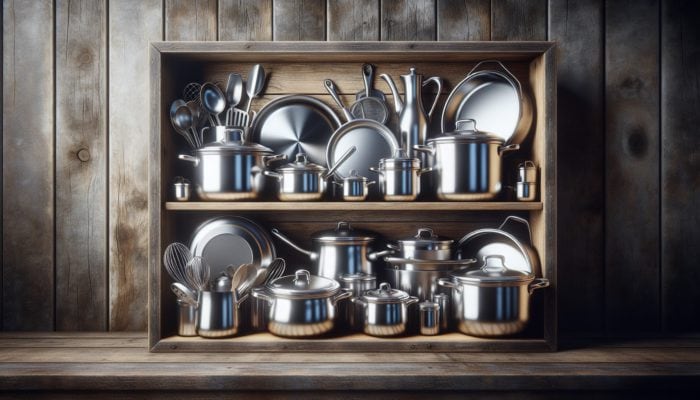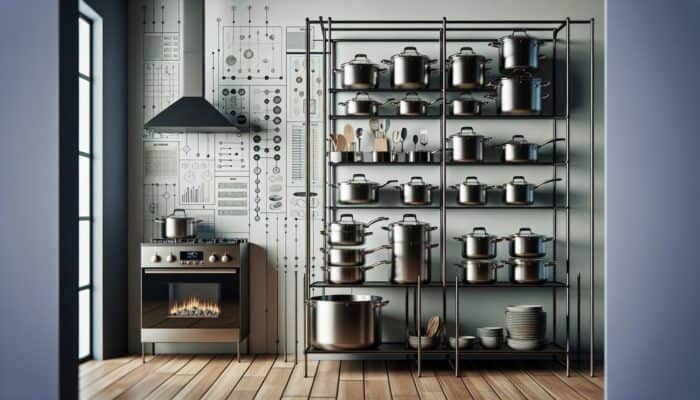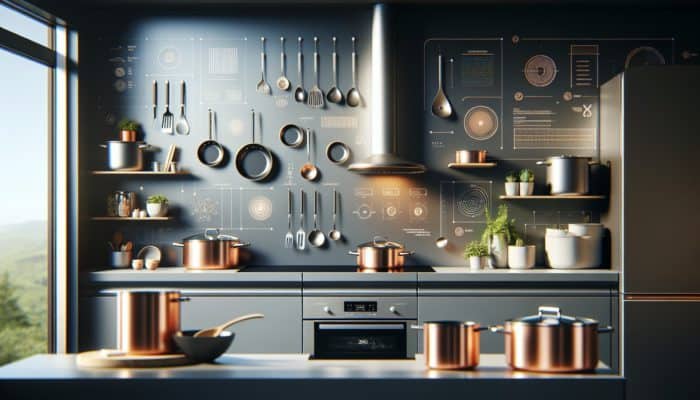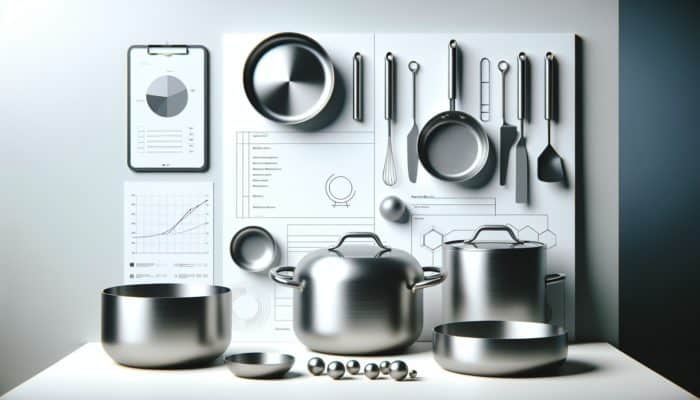Essential Characteristics of Premium Pots and Pans
Choosing Durable Materials for Long-Lasting Cookware

Top Pots and Pans for Small Kitchens: Selecting pots and pans crafted from durable materials is crucial for any kitchen, particularly in compact spaces where every inch counts. When exploring cookware options, focus on materials such as stainless steel and cast iron, both of which are renowned for their strength and ability to withstand daily wear and tear. Stainless steel is especially appreciated for its capacity to endure high temperatures without warping, ensuring even heat distribution. Conversely, cast iron cookware excels in heat retention, making it ideal for achieving a perfect sear on meats or baking rustic bread loaves with ease.
The durability of your cookware has a significant impact on its performance and longevity. For example, a high-quality stainless steel saucepan can withstand years of rigorous use while maintaining its non-reactive surface, which is crucial when preparing acidic ingredients like tomatoes. By investing in robust materials, you minimise the need for frequent replacements, making it an economically savvy and environmentally friendly choice.
Moreover, examine the finish of your cookware. Certain pots and pans come with protective coatings that enhance resistance to scratching and staining. Seek out options that are PFOA-free and nickel-free, as these ensure compliance with health and safety regulations. This careful consideration of material choice not only results in a long-lasting investment but also enhances your overall cooking experience.
Optimising Size and Space in Your Kitchen
In compact kitchens, the size of your cookware plays a pivotal role in maximising efficiency and organisation. Opting for space-saving designs can significantly enhance storage capabilities. Seek pots and pans that nest within one another or feature stackable designs, effectively reducing clutter in your cabinets, which is particularly advantageous in densely populated urban environments where kitchen space is often limited.
Another vital consideration is the weight of your cookware. Lightweight pots and pans are easier to handle, especially in tight cooking environments. For instance, a 2-quart saucepan is the perfect size for boiling pasta or preparing sauces, ensuring it doesn’t consume excessive space. Additionally, specialty items like shallow skillets or sauté pans can double as serving dishes, thus increasing their functionality in your kitchen.
Cookware that performs multiple functions can vastly improve the efficiency of your small kitchen. For example, a frying pan that can also be used for sautéing vegetables or as a shallow baking dish not only conserves space but also decreases the total number of items you need to store. When shopping for pots and pans, concentrate on those that offer maximum versatility without sacrificing quality or performance.
Maximising Versatility in Your Cooking Experience
In the context of cooking in small kitchens, versatility is paramount. Opting for pots and pans capable of accommodating a variety of cooking techniques—from sautéing and simmering to frying and baking—reduces the necessity for a vast array of cookware. This adaptability allows you to prepare a diverse range of meals without cluttering your kitchen cabinets.
For instance, a high-quality sauté pan can serve as both a frying pan and a saucepan, allowing you to prepare everything from stir-fried vegetables to rich sauces. Furthermore, consider cookware compatible with multiple heat sources, including induction, gas, and electric stoves. This flexibility allows you to optimise your cooking potential, regardless of your kitchen setup.
Additionally, it’s wise to choose cookware equipped with sturdy, heat-resistant handles. These features not only enhance the usability of your pots and pans but also contribute to safety, especially when juggling multiple dishes at once. A well-designed multi-cooker can streamline your meal preparation process by allowing seamless transitions between different cooking methods. In our fast-paced world, having versatile cookware in a small kitchen can significantly enhance your cooking efficiency and overall enjoyment.
Insights from Experts on Selecting the Best Pots and Pans for Compact Kitchens

What Qualities Define High-Quality Cookware?
The distinguishing features of high-quality pots and pans significantly enhance your culinary experience. Primarily, seek cookware that offers even heat distribution; this critical characteristic ensures your food cooks uniformly, preventing unsightly burnt or undercooked patches. Non-stick surfaces are equally important, especially for those who prefer cooking with minimal oil or fat, as they simplify both cooking and cleaning.
Here’s a concise bullet list of essential quality indicators to consider:
- Material: Choose stainless steel, cast iron, or high-grade non-stick coatings.
- Heat Distribution: Opt for cookware engineered for even heating.
- Durability: Prioritise resistance to warping, scratching, and staining.
- Ergonomic Handles: Ensure handles are heat-resistant and comfortable to grip.
- Compatibility: Confirm cookware is suitable for various stove types, including induction.
- Oven Safety: Verify if the cookware can withstand high oven temperatures.
- Weight: Select a weight that balances heft and manageability.
- Warranty: A robust warranty indicates confidence in the product's quality.
These critical factors are essential for enhancing the quality of your meals and ensuring the longevity of your cookware. Understanding these elements empowers you to make educated purchasing decisions that will yield long-term benefits. Investing in high-quality cookware not only elevates your culinary abilities but also adds a professional touch to your home cooking.
How Do Experts Advise on Cookware Selection?
Experts recommend a strategic approach when selecting cookware, particularly for small kitchens where space optimisation and functionality are crucial. Begin by assessing your household's cooking habits. For instance, if you frequently prepare stir-fries or one-pot meals, a versatile sauté pan or a Dutch oven may be indispensable. Take into account the size of your family or the typical number of guests you entertain; this consideration will guide you in determining the appropriate capacity for your pots and pans.
Next, evaluate the compatibility of your cookware with your type of stove. If you have an induction cooktop, ensure that you select pots and pans explicitly labelled as induction-compatible. This compatibility is crucial for achieving effective cooking and optimal energy efficiency. Also, consider the materials that best fit your cooking style. For instance, if you enjoy browning meats and deglazing, a heavy-bottomed stainless steel skillet is a fantastic choice.
Lastly, the budget remains a significant factor. While it may be tempting to opt for the lowest-priced items, investing in quality cookware can save you money over time by reducing the frequency of replacements. When in doubt, refer to product reviews and expert opinions to guide your decisions. By following these practical steps, you’ll be well on your way to assembling a functional and efficient cookware collection that caters perfectly to your small kitchen.
What Are the Current Trends in Cookware Design?

Staying informed about the latest cookware trends can greatly enhance your cooking experience, particularly in compact kitchens. A notable trend is the growing popularity of induction-compatible cookware. As more households transition to induction stovetops for their efficiency and speed, the demand for pots and pans designed for this technology is on the rise. These pieces typically feature magnetic bases that facilitate efficient heat transfer.
Eco-friendly materials are also gaining traction, with numerous brands now offering cookware crafted from sustainable sources. Products made from recycled materials or featuring non-toxic coatings are becoming increasingly prevalent, appealing to environmentally conscious consumers. Innovations in non-stick technology, such as ceramic coatings, offer healthier alternatives that are free from traditional chemical coatings, making them safer for everyday use.
Furthermore, the aesthetic design of cookware has become more stylish and functional. Many brands are merging aesthetics with practicality, offering products in various colours and finishes that complement modern kitchen designs. Ergonomically designed handles and stackable options are also trending, specifically catering to those with limited storage capabilities.
Finally, smart cookware is gaining popularity, incorporating features designed to enhance cooking precision and accuracy. Temperature controls and integrated sensors to monitor cooking times are innovations that are becoming more common. These high-tech advancements make cooking more convenient and enjoyable, particularly for those passionate about culinary experimentation.
Which Brands Are Recommended for Small Kitchen Cookware?
When it comes to compact cookware solutions, several brands excel in producing high-quality, space-efficient options. All-Clad is globally recognised for its premium cookware, providing a range of stainless steel pots and pans that are both durable and efficient. Their designs often incorporate stackable or nesting features, making them ideal for small kitchens with limited storage.
Another excellent choice is Calphalon, known for its variety of non-stick cookware that emphasises ease of use and storage. Their skillets, saucepans, and sets cater to various cooking styles and are celebrated for their longevity. The lightweight nature of their cookware is particularly advantageous for individuals with limited strength or mobility.
For those seeking eco-friendly alternatives, GreenPan offers cookware made from sustainable materials. Their ceramic non-stick surfaces are free from harmful chemicals and are compatible with induction cooktops. This brand reflects the growing trend towards health-conscious and environmentally friendly cooking solutions.
Additionally, T-fal is renowned for its budget-friendly options that maintain high quality. Their compact cookware sets often include essential pieces, such as frying pans and saucepans, that fit snugly in small kitchens. T-fal cookware is designed for versatility, enabling home cooks to prepare a wide range of dishes with just one item.
Ultimately, choosing brands recognised for their quality and functionality can significantly enhance your cooking experience in a small kitchen. The right cookware ensures you have reliable tools at your disposal while maximising your cooking space.
How Can You Maximise Storage in a Small Kitchen?
Maximising storage in a small kitchen is vital for functionality and organisation. The objective is to keep your pots and pans easily accessible while minimising clutter. One of the most effective strategies is to utilise vertical space. Consider installing hanging racks or pot rails above your countertops to store frequently used items. This approach not only keeps them within easy reach but also adds a decorative element to your kitchen.
Incorporating stackable cookware is another brilliant method for saving space. Many modern designs allow pots and pans to fit neatly inside one another, significantly reducing their footprint in cabinets. Look for cookware sets that feature removable handles, as these can be particularly effective in creating extra space.
In addition to these methods, consider utilising drawer dividers or pull-out shelves in cabinets. These solutions can help you organise your cookware efficiently, eliminating the need to sift through stacks to locate what you need. Magnetic strips can also be used to hold lids or smaller utensils, making everything easy to find and access.
Finally, don’t overlook the potential of cabinet doors. Attaching hooks for measuring spoons or small pans can dramatically enhance your storage capabilities. By creatively utilising every available space, you can create a well-organised kitchen that feels significantly larger and more functional than it truly is.
Essential Maintenance and Care Guidelines
How to Effectively Clean Your Pots and Pans?
To maintain the appearance and performance of your pots and pans, effective cleaning techniques tailored to the specific materials used are vital. For stainless steel cookware, a combination of baking soda and water can help eliminate burnt-on food residues and restore shine. Create a paste, apply it to the affected areas, and scrub gently with a non-abrasive sponge.
When it comes to non-stick pans, avoid using metal utensils or abrasive cleaners as these can scratch the surface and compromise their non-stick properties. Instead, opt for soft sponges and mild dish soap for routine cleaning. Furthermore, many non-stick products are dishwasher safe, but it’s advisable to review the manufacturer's guidelines before placing them in the dishwasher.
Cast iron cookware requires special care to ensure its longevity. After use, clean it with hot water and a stiff brush; avoid soap, as it can strip the seasoning. Once cleaned, dry the pot thoroughly to prevent rust, and apply a thin layer of vegetable oil to maintain its seasoning.
Here’s a bullet list of cleaning tips for various materials:
- Stainless Steel: Utilise baking soda for tough stains; scrub with non-abrasive sponges.
- Non-Stick: Clean with mild dish soap and soft sponges; avoid metal utensils.
- Cast Iron: Clean with hot water and a stiff brush; dry immediately and lightly oil.
- Copper: Use a mixture of vinegar and salt to restore shine.
- Enamel-Coated: Avoid abrasive cleaners; use a gentle scrubber to prevent chips.
- Glass: Soak in warm, soapy water for easy removal of baked-on food.
- Aluminium: Apply vinegar to eliminate discolouration; avoid prolonged contact with acidic foods.
- Ceramic: Hand wash with non-abrasive cleaners; avoid sudden temperature changes.
Understanding the best cleaning practices for your cookware materials will significantly extend their lifespan and maintain their appearance. By adopting these care strategies, you can ensure your pots and pans remain in peak condition, ready for all your culinary adventures.
Strategies for Preventing Wear and Tear
Regular maintenance is essential for prolonging the life of your cookware, and adopting simple habits can yield significant benefits. One of the most effective preventative measures is to refrain from using metal utensils on non-stick surfaces. Instead, opt for silicone or wooden utensils; these materials are gentle on your cookware and help preserve the surface's integrity.
Additionally, always allow your pots and pans to cool before washing them. Subjecting hot cookware to cold water can cause warping or cracking, especially with materials like ceramic or glass. Instead, let them cool to room temperature before washing with warm soapy water to avoid damage.
When storing your cookware, consider placing protective layers, such as cloth or paper towels, between pots and pans to prevent scratches. This practice prevents scratches and keeps your cookware looking brand new. Also, try to store heavier items on the bottom to avoid crushing lighter pieces.
Moreover, regular seasoning of cast iron cookware is vital for maintaining its non-stick properties and preventing rust. A simple application of oil after cleaning will keep it in optimal condition. By implementing these straightforward strategies, you can effectively prolong the lifespan of your pots and pans and ensure they remain a trusty ally in your kitchen.
Innovative Storage Solutions for Small Spaces
Creative storage solutions can dramatically transform your small kitchen, making it easier to keep your pots and pans organised and easily accessible. One effective strategy is to utilise hanging racks, which not only save space but also serve as a decorative element. Installing a ceiling-mounted rack allows you to showcase your cookware, adding character to your kitchen while keeping your essentials within easy reach.
Another option is to invest in stackable cookware. Many modern pots and pans are designed to nest inside one another, facilitating easy storage without occupying excessive space. Look for sets that include lids that can also be stacked or stored efficiently, as this will further enhance your storage capabilities.
Consider incorporating drawer dividers to keep your cookware organised and easily accessible. Dividers can prevent clanging and scratching, which is particularly beneficial for delicate materials. Pull-out shelves are another fantastic addition, allowing you to maximise cabinet space without the hassle of rummaging through stacks of cookware.
Lastly, don’t forget about the back of cabinet doors. Attaching hooks for lids or smaller utensils can create additional storage opportunities, saving space. By implementing these clever storage solutions, you can optimise your small kitchen's functionality while ensuring that your pots and pans are well-organised and easy to access whenever you need them.
Advantages of Investing in Quality Cookware
Improved Cooking Performance with Quality Cookware
Investing in high-quality pots and pans can significantly enhance your cooking performance, delivering consistent results that elevate your culinary creations. One primary advantage of quality cookware is its ability to distribute heat evenly. This feature prevents hot spots, ensuring that your food cooks uniformly, whether you're sautéing vegetables or simmering sauces. Even heat distribution is especially crucial for baking, where precise temperatures can greatly influence the outcome of your dish.
Moreover, quality cookware often comprises superior materials that enhance heat retention. This trait allows for better browning and searing, bringing out rich flavours in meats and vegetables. When you utilise well-constructed pots and pans, you can achieve restaurant-quality results in your home kitchen, making the cooking process more enjoyable and rewarding.
Another aspect of enhanced cooking performance is the durability of quality cookware. Unlike less expensive alternatives that may warp or degrade over time, high-grade pots and pans can withstand the rigours of daily cooking. This longevity contributes to a more efficient cooking experience and saves you money in the long term since you won’t need to replace your cookware frequently.
Ultimately, investing in quality cookware pays dividends in numerous ways, from improving your cooking techniques to enhancing the overall enjoyment of meal preparation. By selecting well-crafted pots and pans, you pave the way for culinary success.
What Are the Long-Term Financial Benefits of Quality Cookware?
Investing in high-quality cookware not only enhances your culinary experience but also translates into long-term savings. While the initial cost may be higher than that of budget options, the durability and longevity of quality pots and pans mean they won't require frequent replacements. This factor is particularly pertinent in small kitchens, where space limitations necessitate a focus on items that will withstand the test of time.
Quality cookware is designed to withstand the demands of daily use, resisting warping, scratching, and staining. This resilience ensures you won’t need to spend money replacing worn-out items every few years, which can accumulate significantly over time. For instance, a sturdy stainless steel saucepan may be pricier upfront, but it can last a lifetime with proper care, making it a wise investment in the long run.
Additionally, high-quality cookware often performs more efficiently, resulting in superior cooking results. This improved performance can lead to more efficient meal planning and cooking, ultimately saving you money on groceries. When you cook more effectively, you’re less likely to waste ingredients or time, contributing positively to your overall budget.
Overall, the long-term benefits of investing in quality cookware are evident. By selecting durable, high-performance items that align with your cooking needs, you can enjoy better meals while also protecting your finances in the years ahead.
Health and Safety Considerations in Cookware Selection
Health and safety should always be paramount in the kitchen, and the type of cookware you select plays a critical role in this aspect. High-quality pots and pans are often free from harmful chemicals and coatings, making them a safer choice for food preparation. For example, many modern non-stick cookware options are PFOA-free, which mitigates the risk of potentially harmful chemicals leaching into your food.
Moreover, using durable materials such as stainless steel or cast iron can help avoid issues associated with cheaper alternatives that may contain toxins or coatings that degrade over time. These reliable materials not only contribute to healthier cooking but also ensure your meals taste as they should, without any unwanted flavours from the cookware.
Another important consideration is the use of cookware that can withstand high temperatures without releasing harmful substances. Many reputable brands offer oven-safe cookware that can endure the rigours of baking without compromising safety. This feature allows for a seamless transition from stovetop to oven, providing greater flexibility in meal preparation.
By prioritising health and safety in your cookware choices, you create a safer cooking environment for yourself and your family. Quality pots and pans offer peace of mind, knowing you’re cooking with materials designed to support healthy meal preparation.
The Environmental Impact of Choosing Quality Cookware
Opting for sustainable, high-quality cookware can positively impact your kitchen's environmental practices. Quality pots and pans are often constructed from durable materials designed for longevity, reducing the need for frequent replacements that contribute to waste. In contrast, cheaper alternatives often wear out quickly, resulting in increased landfill waste and a larger environmental footprint.
Additionally, many reputable cookware brands are focusing on sustainability by using recycled materials or eco-friendly manufacturing processes. For example, some companies produce cookware from recycled metals or employ biodegradable coatings. By selecting these environmentally conscious options, you support brands that prioritise sustainability in their production practices.
Another consideration is the energy efficiency of your cookware. Quality pots and pans that facilitate even heat distribution require less energy to cook food effectively. This efficiency not only saves you money on energy bills but also contributes to a reduced carbon footprint.
Ultimately, investing in quality cookware enables you to make choices that positively impact the environment while enjoying the benefits of durable and effective cooking tools. By aligning your cooking habits with sustainable practices, you contribute to a healthier planet for future generations.
The Aesthetic and Functional Appeal of Quality Cookware
Quality cookware seamlessly combines aesthetic appeal and functionality, making it a worthwhile investment for any kitchen. Visually appealing cookware can enhance the overall look of your kitchen, especially in in-plan signs, where it makes a statement. Any contemporary brand offers pots and pans in an array of colours and finishes, allowing you to select pieces that resonate with your personal style.
Functional design is equally important, as high-quality cookware often features ergonomic handles and balanced construction. This attention to detail makes cooking more enjoyable and less strenuous, particularly when handling hefty pots or pans. Comfortable handles help prevent fatigue during extended cooking sessions and ensure safety when manoeuvring hot items.
Moreover, a cohesive cookware set can enhance the visual harmony of your kitchen. Investing in pieces that match in style and colour provides a sense of unity, making your kitchen feel more curated and inviting. This aesthetic appeal can also inspire creativity in the kitchen, encouraging you to experiment with new recipes and cooking techniques.
In conclusion, investing in quality cookware allows you to enjoy the dual benefits of stunning design and effective performance. When your cooking tools are not only functional but also beautiful, it enhances the overall cooking experience and adds joy to the process.
Popular Cookware Types for Small Kitchens
What Saucepans Are Ideal for Compact Spaces?
When selecting saucepans for small kitchens, choosing the right size is crucial. A saucepan with a capacity of 1-2 quarts is ideal for various cooking tasks, from heating sauces to boiling small portions of pasta or grains. This size strikes a perfect balance, allowing you to prepare meals without consuming excessive space in your cabinets.
When choosing a suitable saucepan, look for features that enhance functionality and ease of use. For instance, a sturdy, heat-resistant handle is essential, as it provides a secure grip while cooking. Additionally, consider options with a tempered glass lid. This feature allows you to monitor your food without losing heat or moisture, thereby ensuring optimal cooking results.
Another important aspect is the material of the saucepan. Stainless steel is a popular choice for its durability and non-reactive properties, while non-stick coatings can facilitate easy cleanup. However, if you choose non-stick, ensure it is free from harmful chemicals, such as PFOA.
Moreover, consider investing in a saucepan that can fulfil various cooking methods, such as steaming or sautéing. Some models come with steaming inserts or strainers, enhancing their versatility and making them an excellent addition to your small kitchen. By choosing the right saucepan, you can maximise your cooking options without overcrowding your space.
Choosing the Best Frying Pans and Skillets
Frying pans and skillets are essential components of any kitchen, particularly for those with limited space. When selecting these staples, opt for lightweight yet durable options that can handle a variety of cooking tasks, from frying eggs to searing meats. A 10-inch non-stick skillet is an excellent size for small kitchens, providing sufficient cooking surface without overwhelming your stovetop.
Versatility is a key factor; many frying pans can be used for multiple cooking methods, including sautéing, browning, and even baking. For example, a cast-iron skillet can transition easily from stovetop to oven, allowing for diverse cooking techniques. Additionally, some skillets come with lids, which are particularly useful for simmering or steaming.
Look for frying pans with excellent heat conductivity, as this feature ensures even cooking and helps prevent hot spots. Stainless steel and copper are fantastic choices due to their superior heat retention properties. Furthermore, ergonomic handles that remain cool to the touch enhance usability and safety when manoeuvring the pan.
Lastly, consider investing in a frying pan that boasts a non-stick surface for easy cleanup. A well-maintained non-stick skillet will allow you to cook with minimal oil, promoting healthier meals. By choosing the right frying pan, you can create a myriad of delicious dishes while keeping your small kitchen organised and functional.
Incorporating Specialty Cookware Options
In addition to the essentials, adding a few specialty cookware items can enhance your cooking repertoire without consuming much space. For example, a small wok is an excellent addition for those who enjoy stir-frying. Woks are designed for high-heat cooking and can quickly prepare vegetables and proteins, making them a versatile tool for compact kitchens.
Another valuable item is a compact grill pan. These pans feature raised ridges that provide an indoor grilling effect, eliminating the need for a full-size grill. They're perfect for preparing meats, vegetables, and even pancakes, offering versatility while remaining easy to store. Look for grill pans that are compatible with your stovetop type to ensure you get the most out of your purchase.
Additionally, consider a small Dutch oven, which excels in slow-cooking, braising, and baking. These versatile pots can be used on the stovetop or in the oven, making them ideal for a range of cooking techniques. Choose a model that is lightweight and easy to manoeuvre, especially if you're handling it in a compact kitchen setting.
Finally, don’t overlook the value of a quality pressure cooker. This tool can dramatically reduce cooking times for stews, grains, and beans, making it invaluable for busy households. By strategically selecting specialty cookware that expands your cooking possibilities, you can enhance your culinary skills without cluttering your small kitchen.
How to Select the Ideal Cookware Set
Evaluating Your Cooking Requirements
Choosing the right cookware set commences with a thorough evaluation of your cooking requirements. Start by examining your typical cooking habits—do you frequently prepare large meals for a family, or do you primarily cook for one? Understanding your household's culinary needs will considerably influence your selection process.
Consider the types of dishes you enjoy making. If you often create stir-fries, a set that includes a wok or a large skillet may be essential. Conversely, if baking is more your style, ensure that the cookware set includes oven-safe pieces, such as a roasting pan or a Dutch oven.
Additionally, reflect on how often you cook. For those who cook daily, investing in a higher-quality set made from durable materials like stainless steel or cast iron can yield long-term benefits. However, if you’re an occasional cook, a more budget-friendly option may suffice.
Lastly, assess your storage options. If space is at a premium, look for sets that include stackable or nesting pieces. Sets that come with lids that can also be stored efficiently will help maximise your storage options. By understanding your cooking needs and preferences, you can select a cookware set that will serve you well for years to come.
Comparing Various Cookware Sets
When comparing different cookware sets, it's essential to consider the combination of pieces offered and how well they align with your cooking style. Look for sets that provide a balance of essential items, such as skillets, saucepans, and a stockpot, along with specialty pieces that you might find useful.
Pay close attention to the materials used in each set. Stainless steel, cast iron, and high-quality non-stick options are generally more durable and offer superior cooking performance compared to cheaper alternatives. Assess whether the cookware is suitable for your heating source, such as induction, gas, or electric, to ensure compatibility.
Another significant factor is the warranty. A reputable brand that offers a solid warranty demonstrates confidence in the quality of its products. This assurance can be crucial in case of defects or issues arising from regular use. Additionally, consult customer reviews to gauge satisfaction levels and common experiences with the cookware sets you’re considering.
Finally, consider the price-to-value ratio. While it’s tempting to choose the cheapest option, investing in a quality set often proves more economical in the long run. Evaluating the features, materials, and warranty provided by each set will help you make a well-informed decision.
What Features Are Crucial in a Cookware Set?
When selecting a cookware set, several key features should be prioritised to ensure you get the best value for your investment. First and foremost, look for items with non-stick surfaces, which can significantly enhance your cooking experience by allowing for easy food release and effortless cleaning. Ensure that these surfaces are free from harmful chemicals, promoting safer cooking practices.
Another important feature is oven safety. Many high-quality cookware sets can withstand high temperatures, making them versatile for a wide range of cooking methods. Look for pieces that can transition seamlessly from stovetop to oven, expanding your culinary possibilities.
Consider the materials used in the cookware set. Stainless steel is lauded for its durability and stain resistance, while cast iron excels in heat retention and natural non-stick properties when properly seasoned. Non-stick options are ideal for low-fat cooking, whereas copper cookware offers exceptional heat conductivity.
Additionally, ergonomic handles are vital for safety and comfort. Look for handles that remain cool to the touch and provide a secure grip, making it easier to lift and manoeuvre your pots and pans. Lastly, consider the overall weight of the cookware; lighter options can be easier to handle, especially in smaller kitchens where space is limited.
By concentrating on these features, you can ensure that you select a cookware set that meets your cooking needs while providing the durability and functionality essential for a successful kitchen experience.
Frequently Asked Questions
Which materials should I seek in pots and pans?
Aim for durable materials like stainless steel, cast iron, and high-quality non-stick surfaces. Each offers unique advantages, such as heat retention and easy cleaning, making them ideal choices for various cooking methods.
How can I organise my cookware in a compact kitchen?
Utilise vertical space with hanging racks, choose stackable cookware, and incorporate drawer dividers. These strategies can help keep your pots and pans organised and easily accessible.
What is the optimal size saucepan for a small kitchen?
A 1-2 quart saucepan is ideal for small kitchens, enabling you to prepare sauces and small portions without occupying excessive space. Look for features that enhance usability, such as a tempered glass lid.
Are non-stick pans safe for use?
Yes, non-stick pans are safe when free from harmful chemicals like PFOA. Select high-quality options and refrain from using metal utensils to preserve their non-stick properties.
How often should I replace my cookware?
The lifespan of cookware varies by material and quality, but high-quality pots and pans can last for many years. Regular maintenance and proper care can further extend their longevity.
Is it advisable to use metal utensils on non-stick cookware?
It’s best to avoid metal utensils on non-stick cookware, as they can scratch the surface and degrade its performance. Opt for silicone or wooden utensils instead.
What distinguishes a frying pan from a skillet?
There’s no significant difference; both terms are often used interchangeably. However, skillets may feature slightly higher sides, making them more versatile for various cooking techniques.
How do I properly maintain cast-iron cookware?
Clean your cast iron with hot water and a stiff brush, avoiding soap. Dry it thoroughly to prevent rust, and apply a thin layer of vegetable oil to maintain its seasoning.
What features enhance the cooking performance of pots and pans?
Look for even heat distribution, heat retention capabilities, and ergonomic handles. These features contribute to better cooking results and a more enjoyable cooking experience.
Is it necessary to have a complete cookware set?
Not necessarily. Assess your cooking habits and select essential pieces that fit your needs. A smaller set can be more practical for small kitchens, focusing on versatile pieces that are easy to use and maintain.



I really appreciate your insights on durable materials for cookware, especially in the context of small kitchens. Having moved into a compact space recently, I’ve had to rethink my kitchen essentials, and I’ve found that investing in quality pots and pans makes all the difference.
It’s great to hear you’re finding value in quality cookware. In smaller kitchens, every inch counts, so choosing the right pots and pans can really elevate your cooking experience. Have you found any specific materials that work best for your space? I’ve seen a lot of people lean toward multi-functional pieces—like a good cast iron skillet that can go from stovetop to oven. It not only saves space but also adds a nice bit of flavor to what you cook. Plus, they’re durable, which is a huge bonus when you’re investing in your kitchen essentials. Would love to hear how you’re making your compact space work!
You’ve touched on an important aspect of kitchenware that often gets overlooked, especially in smaller spaces. I’ve found that investing in high-quality pots and pans really makes a difference in my cooking experience. For instance, I have a cast iron skillet that I’ve had for years; it’s become my go-to for anything from searing meats to baking cornbread. The way it retains heat is truly unmatched, and I love how it gets better with each use—seasoning it has almost become a ritual for me!